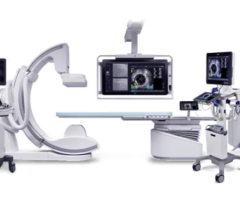
September 24, 2019 – Medtronic announced U.S. Food and Drug Administration (FDA) approval and U.S. launch of the Evolut Pro+ transcatheter aortic valve replacement (TAVR) system. The new-generation Medtronic TAVR system builds off the self-expanding, supra-annular Evolut TAVR platform. The Evolut Pro+ TAVR System includes four valve sizes with an external pericardial tissue wrap that provides advanced sealing for the largest indicated patient treatment range and the lowest delivery profile currently on the market, according to Medtronic. The launch comes on the heels of the FDA’s recent indication expansion for the Evolut TAVR platform to treat patients with symptomatic severe aortic stenosis at a low risk of surgical mortality, the final surgical risk category to be approved for TAVR.
Read the article "FDA Approves TAVR for Low-risk Patients Creates A Paradigm Shift in Cardiology"
“As TAVR becomes a preferred treatment option for more patients with severe aortic stenosis, it’s critically important to have valve technology available that keeps pace with the evolution of the therapy,” said Mathew R. Williams, M.D., director of the Heart Valve Program at the NYU Langone Health in New York City. ”Valve technologies that are designed to help minimize paravalvular leak, simplify the valve delivery during the procedure, and for unobstructed blood flow are factors that have made TAVR an excellent choice for many patients.”
The Evolut Pro+ TAVR System can treat the broadest annulus range and offers the lowest delivery profile on the market according to Medtronic (the 23-, 26- and 29-mm valves can treat vessels down to 5 mm). It features four valve sizes – including the 34 mm (treats vessels down to 6 mm) – with an external tissue wrap and an integrated, inline sheath, allowing physicians to treat patients with a range of anatomical variations. Consistent with the Evolut platform design, the Pro+ valve is designed with a self-expanding nitinol frame that conforms to the native annulus with consistent radial force and advanced sealing. The valve incorporates an outer porcine pericardial tissue wrap that adds surface area contact and tissue interaction between the valve and the native aortic annulus to help potentially reduce incidences of paravalvular leaks.
“Physicians are treating a broader range of patient anatomies than ever before – from large to small, from simple to complex,“ said Guilherme Attizzani, M.D., interventional cardiologist and director Valve and Structural Heart Disease Center at University Hospitals in Cleveland. ”Adding the external tissue wrap to the large 34mm valve size, which wasn’t previously available, is a major technological improvement that will benefit many patients with larger anatomies.”
Severe aortic stenosis occurs when the aortic valve leaflets become stiff and thickened and have difficulty opening and closing, making the heart work harder to pump blood to the rest of the body and, therefore, impacting an individual’s daily activities. If left untreated, patients with symptomatic severe aortic stenosis can die from heart failure in as little as two years.
The Evolut TAVR platform, including the Evolut R, Evolut Pro and Evolut Pro+ systems, is indicated for symptomatic severe aortic stenosis patients across all risk categories (extreme, high, intermediate and low) in the U.S.
For more information: www.medtronic.com
Related TAVR Content
National Coverage Determination Will Make TAVR Available to More Patients at More Centers
VIDEO: TAVR Stands Equal to Surgical Valve Replacement — Interview with Michael Reardon, M.D.
Study Finds TAVR Can Be Considered for Patients in All Surgical Risk Classes
VIDEO: Edwards Lifesciences Sapien 3 TAVR Procedural Animation
TAVR Performs Well Compared to Surgical Aortic Valve Replacement in Low Risk Patients
CMS Finalizes Updates to Coverage Policy for Transcatheter Aortic Valve Replacement
TAVR Outperforms Surgery in Younger, Low-Risk Aortic Stenosis Patients
VIDEO: Tracking Transcatheter Valve Outcomes in the STS-ACC TVT Registry — interview with John Carroll, M.D.
Interventional Imagers: The Conductors of the Heart Team Orchestra
Boston Scientific Receives FDA Approval for Lotus Edge Aortic Valve System
Length of Stay Impacts TAVR Outcomes
VIDEO: TAVR For Asymptomatic Severe Aortic Stenosis — Interview with Philippe Genereux, M.D.
How to Perform Transcaval TAVR Access
The Essentials of Structural Heart Imaging
Hospital Consolidation May Increase Access to TAVR, New Cardiac Technologies
VIDEO: Outcomes Following Urgent TAVR - Results from the TVT Registry — Interview with Sammy Elmariah, M.D.
Valve Replacement Volume Key to Successful Patient Outcomes
TAVR Operator and Hospital Requirements Outlined in 2018 AATS/ACC/SCAI/STS Expert Consensus
VIDEO: Overview of University of Colorado Structural Heart Program
VIDEO: TAVR for Degenerated Surgical Valves, Valve-in-Valve TAVR Procedures — Interview with Sammy Elmariah, M.D.
VIDEO: Advice For Hospitals Starting a Structural Heart Program — interview with John Carroll, M.D.
VIDEO: How to Get Referral Patients Into a Structural Heart Program


 December 20, 2023
December 20, 2023 








